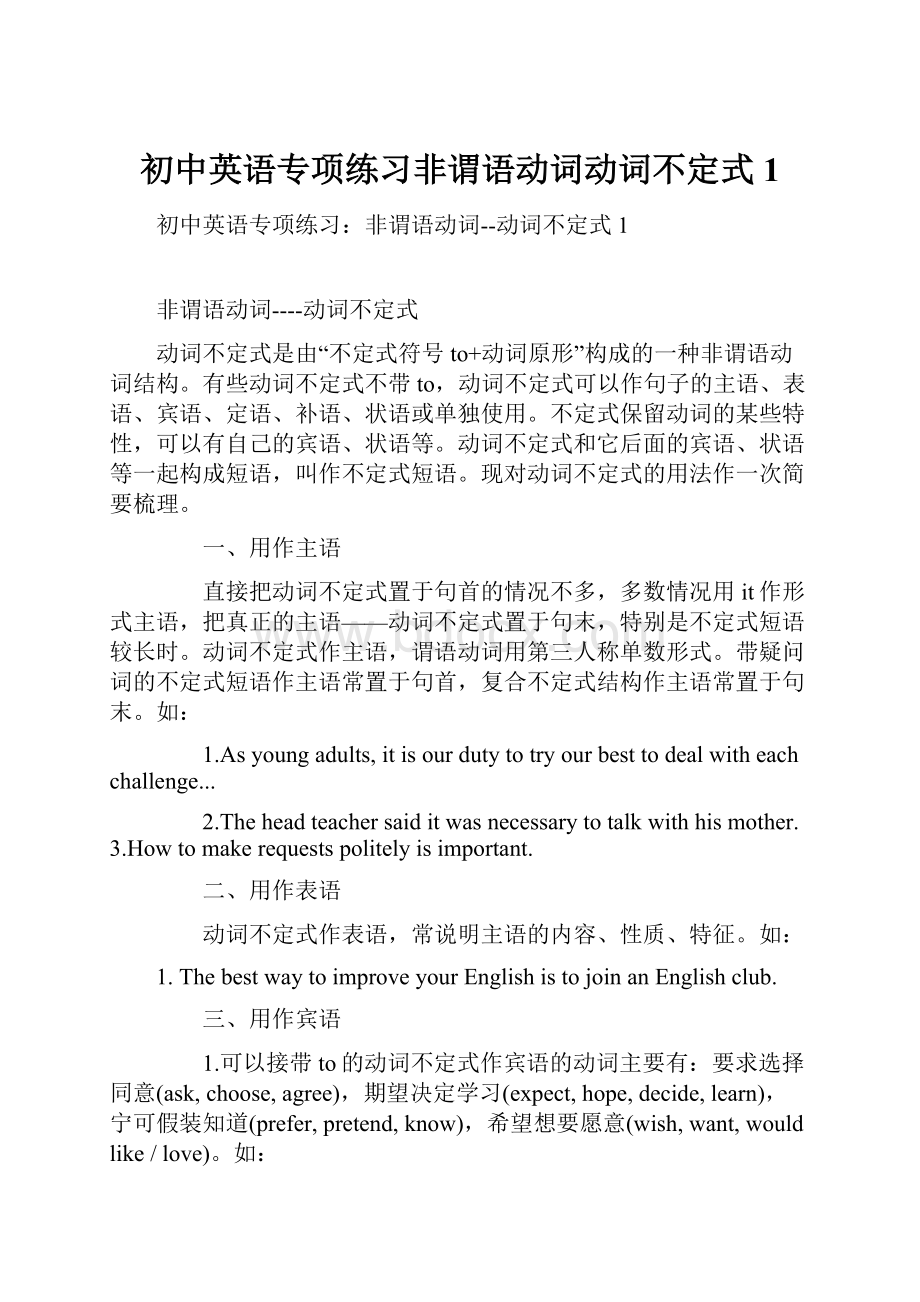初中英语专项练习非谓语动词动词不定式1.docx
《初中英语专项练习非谓语动词动词不定式1.docx》由会员分享,可在线阅读,更多相关《初中英语专项练习非谓语动词动词不定式1.docx(8页珍藏版)》请在冰豆网上搜索。

初中英语专项练习非谓语动词动词不定式1
初中英语专项练习:
非谓语动词--动词不定式1
非谓语动词----动词不定式
动词不定式是由“不定式符号to+动词原形”构成的一种非谓语动词结构。
有些动词不定式不带to,动词不定式可以作句子的主语、表语、宾语、定语、补语、状语或单独使用。
不定式保留动词的某些特性,可以有自己的宾语、状语等。
动词不定式和它后面的宾语、状语等一起构成短语,叫作不定式短语。
现对动词不定式的用法作一次简要梳理。
一、用作主语
直接把动词不定式置于句首的情况不多,多数情况用it作形式主语,把真正的主语——动词不定式置于句末,特别是不定式短语较长时。
动词不定式作主语,谓语动词用第三人称单数形式。
带疑问词的不定式短语作主语常置于句首,复合不定式结构作主语常置于句末。
如:
1.Asyoungadults,itisourdutytotryourbesttodealwitheachchallenge...
2.Theheadteachersaiditwasnecessarytotalkwithhismother. 3.Howtomakerequestspolitelyisimportant.
二、用作表语
动词不定式作表语,常说明主语的内容、性质、特征。
如:
1.ThebestwaytoimproveyourEnglishistojoinanEnglishclub.
三、用作宾语
1.可以接带to的动词不定式作宾语的动词主要有:
要求选择同意(ask,choose,agree),期望决定学习(expect,hope,decide,learn),宁可假装知道(prefer,pretend,know),希望想要愿意(wish,want,wouldlike/love)。
如:
1)Wedecidedtotalktosomestudentsaboutwhytheygothere.
2.动词decide,know,learn,show,teach,tell...,介词结构on...可用疑问词带to的不定式短语作宾语,但why后面的不定式不带to。
如:
1)Couldyoupleasetellmewheretoparkmycar?
2)Itgivesadviceonwhattodoinlotsofdifferentsituations.
3.动词feel,find,make,think等后面,可以用it作形式宾语代替真正的宾语——动词不定式,句子结构是...feel/find/make/...it+adj./n.+todo...。
如:
Ifinditdifficulttoremembereverything.
4.既可接动词不定式又可接ving形式作宾语,意思差别不太大的动词有begin,start,like,love等。
一般说来,动词不定式表一次、数次的具体动作、将来动作或动作的全过程,ving形式表习惯性的连续动作。
但是这种区别并不很严格,特别是美国英语,即使是习惯性的动作也可以用动词不定式。
如:
1)ThenIstartedtowatchEnglish-languageTV.
2)I’mbeginningtounderstandmyChineseroots,andwhoIam. begin用了进行时态,后面只接不定式作宾语,表示事情刚开始,还要继续下去。
3)Iliketoeatvegetables.
感知动词like,love,know等一般不用进行时态。
5.后接动词不定式或ving形式作宾语,意思差别较大的动词有forget,remember等。
后接不定式作宾语,表动作尚未发生;后接ving形式作宾语,表动作已经发生。
stoptodo停下来做另外一件事,todo是目的状语;stopdoing停止做、不做当前这件事,doing是宾语。
trytodo尽力做,trydoing试试看;goontodo接着做另外的事,goondoing继续做原来的事。
如:
1)WhenIlefthome,Ihadforgottentobringitwithme.
2)Istoppedusingthemlastyear.
四、用作定语
1.句子的主语或宾语是动词不定式的逻辑主语,不定式与其所修饰的名词、代词等存在逻辑的动宾关系时,用动词不定式的主动式。
如:
1)Ihavesomanychorestodotoday.
2)Icantthinkofanygoodadvicetogiveher.
3)Basketballhasalsobecomeamorepopularsportforpeopletowatch. 2.动词不定式所修饰的名词是place,time,way等时,不定式与这些名词呈现出动状关系或同位关系。
如:
1)Heneedstimetodohomework.
2)Isthatagoodplacetohangout?
3)Youwanttoknowthebestwaytogetaroundthecity.
3.在“therebe...”句型里,句子的主语是动词不定式动作的对象,常用主动式。
如:
1)There’sjustsomuchtoseeanddohere.
2)...buttherearestillmanythingstodothere.
五、用作补语
动词不定式作补语时,在主动语态句里补宾语,在被动语态句里补主语,句子的宾语或主语是不定式动作的逻辑执行者。
如果不定式是tobedone,句子的宾语或主语就是逻辑承受者。
1.在主、被动语态句里用带to的动词不定式作补语的动词主要有:
要求允许提议(ask,allow,permit,advise),期望邀请鼓励(expect,suppose,invite,encourage),教导告诉想要(teach,tell,want),等待希望愿意(waitfor,wish,wouldlike/love)。
如:
1)Idinvitehertohavedinneratmyhouse.
2)Teenagersshouldbeallowedtochoosetheirownclothes.
2.动词不定式作补语,在主动语态句里不带to,被动语态句里带to时多数动词是感官动词和使役动词,包括四“看”:
lookat,observe,see,watch,三“让”:
have,let,make,二“听”:
hear,listento,一“感觉”:
feel,一“注意”:
notice。
如:
1)Thispicturemakesmefeeltense!
2)OfcoursewewanttoseeLiuYuachievehisdreams.
3.help后接动词不定式作补语,to可带可不带。
一般说来,带to表间接帮助,不带to表直接帮助。
在被动语态句里,或者用不定式的否定式作补语时要带to。
如:
1)...theycanhelpyoutocomparetwodifferentproductssothatyoucanbuytheoneyoureallyneed.
2)UsingemailEnglishhelpsyouwritequickly.
4.besaid,besure,happen,seem等后面可以接带to的动词不定式作主语的补语。
如:
1)Hedoesn’tseemtohavemanyfriends.
2)Besurenottomissthemiftheycometoacitynearyou.
六、用作状语
1.目的状语,置于句首或句末,置于句首时常表示强调。
如:
1)Inordernottooffendpeople,learningaboutlanguageetiquetteisjustasimportantaslearninggrammarorvocabulary.
2)Agroupofyoungpeoplegottogetherto(inorderto/soasto)discussthisquestion.
todo/inordertodo/soastodo用作目的状语,置句末时都可以用,置句首时只用todo/inordertodo。
soastodo一般不置于句首,可以引导结果状语从句,inordertodo不引导结果状语从句。
2.原因状语,多见于“sb.+be+adj.+todo...”结构句中。
如:
1)Mydog’snameis“Lucky”—agoodnameforhimbecauseIfeelveryluckytohavehim.
2)OnMondayhetoldaradiointerviewerthathehadrunoutofmoneytobuyoldbikes.
3.结果状语,多见于“too...to”,“enoughto...”结构句中。
如:
1)ThenI’mtootiredtodowell.WhatshouldIdo?
2)Theroomneedstobebigenoughforthreepeopletolivein.
4.有些动词不定式作状语,常说明前面形容词的性质和特性。
动词不定式与句子的主语有逻辑的动宾关系。
动词不定式前面的形容词一般是:
cheap,dangerous,difficult,easy,fun,hard,interesting,necessary。
不定式常用主动式表被动意义。
...themistakesyoumadearenecessaryforyoutolearnandunderstand. 这类句子中的动词不定式可改为主语。
5.独立动词不定式多用作插入语,表示说话人的心理状态或对事情的看法。
如:
1)I’dliketostayhealthy,buttobehonest,Ionlyeatfoodthattastesgood.
2)Tobeginwith,shespoketooquickly,andIcouldn’tunderstandeveryword.
七、动词不定式的复合结构
动词不定式的复合结构是“for/ofsb.todosth.”,for/of引出不定式动作的逻辑主语。
这种结构在句子中可以作主语、宾语、表语、定语、状语等。
不定式复合结构的介词用for还是of,主要决定于前面形容词的性质。
一般说来,of前面的形容词是careful,clever,foolish,good,kind,nice,wise等,既说明人的特性,又说明不定式动作的特性。
for前面的形容词是dangerous,difficult,easy,hard,heavy,important,interesting,necessary等,一般说明不定式动作的特性,不说明人的特性。
前面如果是名词用for。
如:
1.Itsalsoprobablyagoodideaforparentstoallowteenagerstostudyingroupsduringtheevening.
2.Zoosareterribleplacesforanimalstolive.
八、带疑问词的不定式短语
动词不定式前面可以带疑问代词what,which,who或疑问副词how,when,where,why等。
这种结构起名词的作用,在句子里用作宾语、主语、表语等,或者单独使用。
要注意的是,why后面的不定式不带to。
如:
1.用作句子的成分。
1)Idon’tknowwhattotrynext.(作宾语)
2)Wheretogoisnotdecidedyet.(作主语)
2.单独使用时相当于一个特殊疑问句。
1)Whattodonext?
(=Whatwillwe/youdonext?
)
2)Whygothere?
(=Whydowe/yougothere?
)
九、动词不定式的否定式
不定式的否定式是not/nevertodo...,不带to的不定式的否定式是not/neverdo...如:
1.Sometimestheyhavedisagreements,anddecidenottotalktoeachother.
2.Hisparentstellhimnevertodriveafterdrinking.
练习题
1.用括号中的动词适当形式填空
1.Wearesoglad________(hear)thenews.
2.Isawhim________(cross)theroadsafelyand________(run)away.
3.Youcan’tmakehim________(do)whatyouwant.
4.Idon’tknowwhere________(meet)him.
5.Whatmakesyou________(think)I’mafarmer?
6.Didyouseehim________(go)upstairs?
7.Itisbetter________(put)yourmoneyinabank.
8.Itisdifficultfortheboy________(swim)acrosstheriver.
9.Ilethim________(go)earlyashewanted________(meet)hisuncleatthestation.
10.Willyouhelpme________(move)thebed?
11.Ifhedoesn’tknow,how________(use)therecorder,you’dbetter________(show)him.
12.Heisthelastone________(leave)theofficeeveryday.
13.It’sbadmanners________(shout)inpublic.
14.Theboyisoldenough________(dress)himself.
15.Sheistooill________(go)toschool.
2.选择填空
1.Pleaseremember________thedoorbeforeyouleavetheroom.
A.lock B.locking C.tolock D.locked
2.Thepolicetoldtheboys________ontheroad.
A.don’tplayfootball B.nottoplayfootball
C.notplayingfootball D.don’ttoplayfootball
3.Thegirlisoftenheard________innextroom.
A.sing B.tosing C.sang D.singing
4.Heknows________.
A.whatdonext B.whattodonext C.whattodoitnext D.whattodothenext
5.Hedidn’tknow________.
A.howgetthere B.howtogetthere C.wheretogetthere D.whengetthere
6.Wedidn’tstop________untilwereachedtheend.
A.havingarest B.tohavearest C.tohavingarest D.havearest
7.It’snoteasyforme________thework.
A.finishing B.tofinishing C.tofinish D.finished
8.Pleasetellme________.
A.tochoosewhich B.whichtochoose
C.whichchoosetheone D.choosetowhich
9.Thetravelerwasseen________ahorse.
A.fellfrom B.fallfrom C.fellingfrom D.tofallfrom
10.Wearegoingtohaveher________withAuntWang.
A.tolive B.living C.live D.lived
11.Pleasegivethechildapen________.
A.towriteby B.towritefor C.towritewith D.writewith
12.Theteacherexpectedallhisstudents________harder.
A.studying B.tostudy C.studied D.study
13.Itisnecessary________variouskindsoffoodeveryday.
A.ofustoear B.foruseat C.ofuseat D.forustoeat
14.Iwouldlike________yournewbicycle.
A.tosee B.seeing C.see D.saw
15.Itisveryhothere.Wouldyoumind________thewindow?
A.toopen B.opening C.open D.toopening